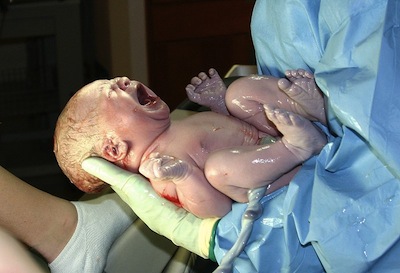
APGAR Scores
last authored: Jan 2009, David LaPierre
last reviewed: Oct 2011, Genevieve Dinga-Carr
Introduction

healthy newborn (APGAR of 9) couresty of Ernest F
The Apgar scores, named after Dr Virginia Apgar, are used to determine neonatal health, and are measured at 1 min, 5 min, and reassessed at intervals thereafter if needed. In use since 1953, they remain a relevant predictor of neonatal survial (Casey et al, 2001).
Scoring
A full score is 10.
Aide memoire:
How Ready Is This Child?
|
0 |
1 |
2 |
Heart Rate |
none |
<100 |
100-180 |
Resp Effort |
none |
poor |
good/crying |
Irritability |
none |
grimacing |
cough/crying |
Tone |
none |
some flexion |
active m ovement |
Colour |
blue-gray, or pale |
centrally pink; |
fully pink |
Interpretation
Apgar scores were designed to assess response to obstetric anaesthesia, and not identify emergency situations. However, mortality does correlate quite well with Apgar scores; in one study, a five min score of 0-3 was associated with a mortality of 244/1000 infants, compared with 0.2/1000 infants with a score of 7-10 (Casey et al, 2001).
Healthy infants are typically receive a score of 8-10, though a full score is rare due to usually peripheral cyanosis (acrocyanosis). They may need some recuscitation, as directed by clinical assessment, but usually do fine on their own.
Infants who are in distress will usually receive a score of 6 or less. Given their clinical presentation, for example poor respiratory effort, neonatal recuscitation will have commenced before the Apgar scores are even calculated. As such, calculating an Apgar score is of limited use in an situation where an infant requires recuscitation. In this case, proceed with neonatal recuscitation protocols.
Resources and References
Casey BM et al. 2001. The continuing value of the Apgar score for the assessment of newborn infants. NEJM. 344(7): 467-471.
